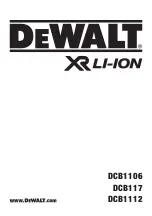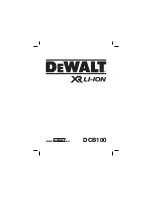
Prime Series
9 of 20
User’s Manual
3. BATTERY TYPE
This charger was factory-configured to charge the type of battery indicated in the BATTERY field on the
charger rat
ings label (for example, “Wet”). The 13
th
and 14
th
characters in the charger part number, available
in the PART NO field on the charger ratings label, provide the charge profile code for the primary charge
profile. For example, charger part number 28480J83A1B1W1
has a primary battery profile code of “W1” and
charger part number 28480J83G1B1A1
has a primary battery profile code of “A1”. Figure 3-1 lists standard
charge profile codes and their corresponding charge profiles. If the battery profile code for your charger is
not listed in Figure 3-1, please contact your dealer for information. To change the active charge profile for
this charger, please contact your dealer. If the active charge profile is changed, mark the charger ratings
label and/or add an additional label or tag.
CAUTION: THIS CHARGER IS FOR USE ONLY WITH BATTERY SYSTEMS OF THE SAME TYPE AS
THE ACTIVE BATTERY PROFILE. BATTERIES IMPROPERLY MATCHED WITH THE CHARGER MAY
BURST CAUSING PERSONAL INJURY AND DAMAGE TO THE BATTERIES OR CHARGER.
Model
Rating
Part Number Battery
Profile Code
Battery Profile
28480
24V/12A
W1
Wet, CC-CV-CC, 3A finish
W2
Wet, CC-CV-CC, 3.5A finish
W3
Wet, CC-CV-CC, 4A finish
A1
AGM, CC-CV-CC, 1.8A finish
A2
AGM, CC-CV
A3
AGM, CC-CV- Float
G2
Gel, CC-CV
G3
Gel, CC-CV- Float
Figure 3-1: Standard Battery Profile Codes and Their Corresponding Battery Profiles
Battery manufacturers frequently use the same battery cases for different battery types. Wet/flooded
batteries have removable cell caps. Water electrolyzed by discharging and charging the battery is replaced
through these openings. Sealed batteries are generally distinguished by non-removable cell caps. The
physical appearance of the battery case is frequently the same as a wet battery, though the cell caps are
generally not removable. Refer to the battery manufacturer's information panel on the battery case to
determine the type battery you have. If the information panel is missing or not legible, do not use the battery.
4. OFF-BOARD (SHELF) VERSUS ON-BOARD (BUILT-IN) CHARGERS
4.1 Off-Board Chargers
Off-board chargers are designed to be used in shelf or portable applications. If the AC input plug is
connected to AC power, a new charge cycle automatically starts when the DC output is connected to a
battery pack of the proper voltage. Disconnecting and reconnecting AC power while the DC output remains
connected to a battery pack WILL NOT automatically start a new charge cycle. Disconnecting the DC output
from the battery pack IS REQUIRED to automatically start a new charge cycle.
4.2 On-Board Chargers
On-board chargers are designed to be mounted on electric vehicles/equipment. If the DC output is connected
to a battery pack of the proper voltage, a charge cycle automatically starts when the AC input plug is
connected to AC power (unless a safety period of time has not passed since the successful completion of the
previous charge cycle). Disconnecting the DC output from the battery pack is NOT REQUIRED to
automatically start a new charge cycle.






































